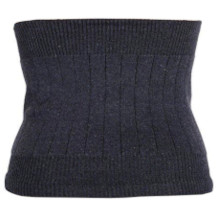Infrared lamp purchasing advice: how to choose the right product
- What You Need to Know
- Infrared lamps work with heat rays to improve blood circulation.
- They are used, for example, for muscle complaints, tension, cold symptoms and impure skin.
- While area radiant heaters are suitable for large-area treatment, the much handier round radiant heaters are used for punctual radiation.
- The wattage, the radiation field and features such as a timer and overheating protection shape the purchase decision.
Seeing red in a good way
The answer of an iconic film character to the question what blue light does remains legendary: “It glows blue”. There is nothing to add to that. With red light, the explanation is more nuanced, but the basic assumption is that red light can have a positive effect on the body in several ways. That is true, but why is it so?
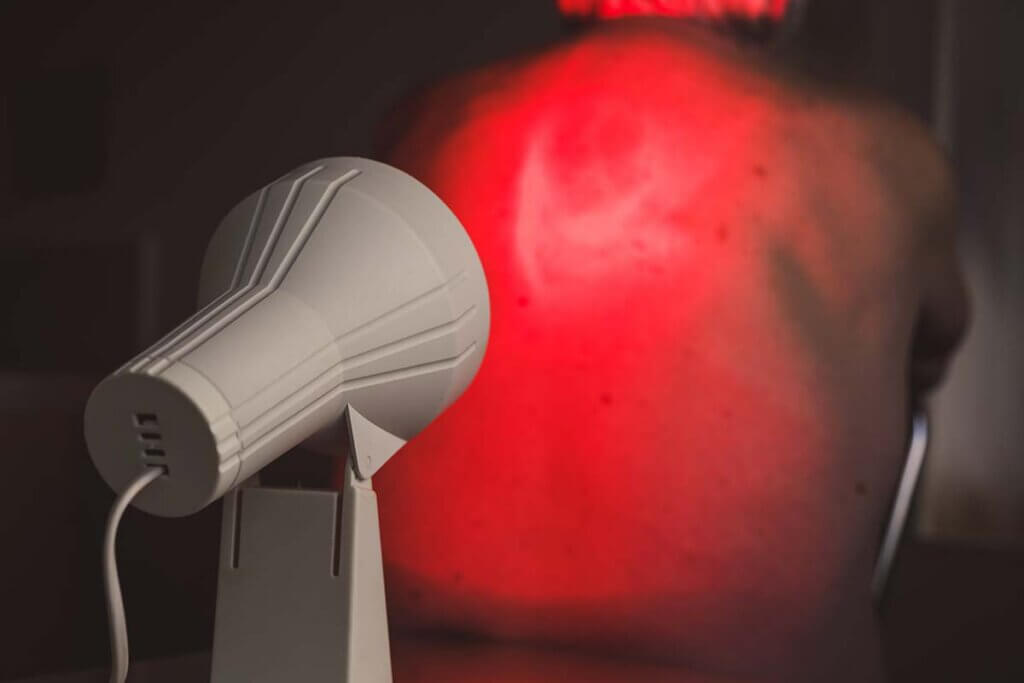
What is an infrared lamp?
In fact, infrared lamps are not only used in private settings, but also in therapeutic treatments. The technically correct term is infrared lamp, but the colloquial term red light lamp – or heat lamp – is more common. Either way, these are products that have a medical purpose and are intended to help alleviate various ailments. This works by means of heat rays that slightly increase the tissue temperature, dilate the vessels and in this way can improve the local blood circulation.
How infrared light creates heat
From a physical point of view, heat rays are electromagnetic waves on which, simply put, charged particles move – this also applies to radio waves and X-rays. The differences lie in the wavelength: while the distances between two wave peaks are small for X-rays and large for radio waves, heat rays are in between. Because the particle waves equally agitate particles in the body, heat is generated.
What are infrared lamps used for?
Heat lamps are used for a wide variety of purposes and are always useful when heat can be applied to achieve a result. Many people use them to relieve tension and other muscular complaints – for example after sport or in old age. However, an infrared lamp is also used to treat non-chronic bronchitis and to alleviate typical cold symptoms such as a feeling of pressure on the sinuses.
Concrete examples of the use of infrared lamps:
- Sore muscles
- Tension
- Lumbago
- Earache
- Sinus pressure
- Sore throat
- Rheumatic complaints
- Fibromyalgia
Infrared lamps have an additional effect: during local application, the body benefits from the rays because purification processes can begin due to a boosted metabolism. In addition, the red light is said to open the pores and thus have a cosmetically beneficial effect on impure skin. Last but not least, heat lamps fulfil the desire for a short relaxation time.
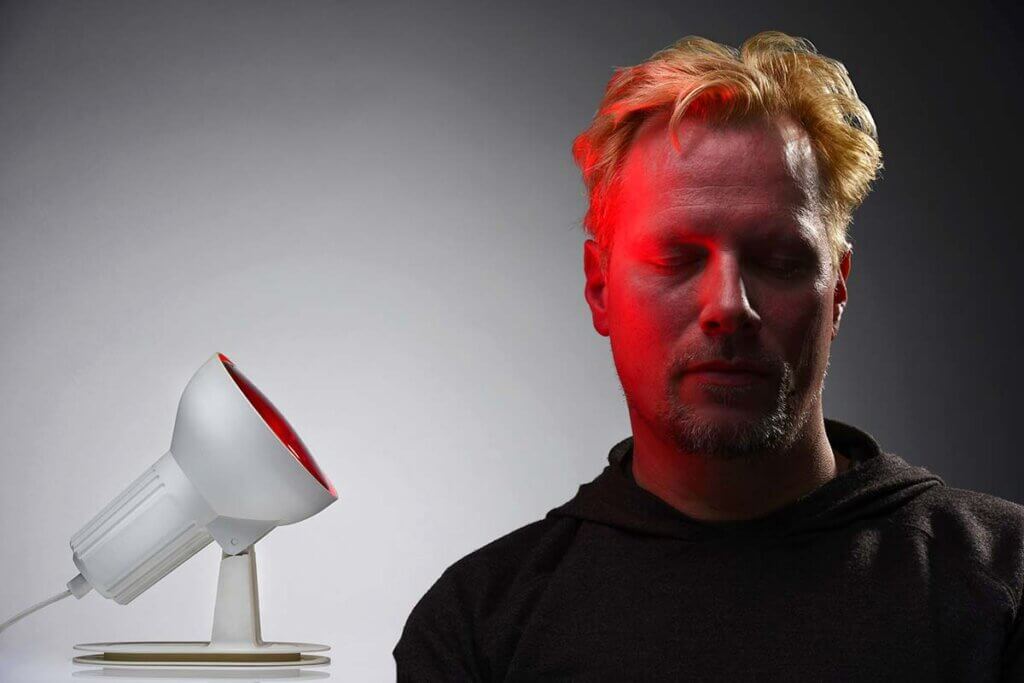
However, always make sure to use them appropriately. When irradiating the face, for example, you should wear protective goggles because the infrared rays can damage the eyes even when the eyelids are closed. There is also a risk of burns if heat lamps are not used properly. If you like to go to the solarium, it is better not to use the infrared lamp; experts advise against the combination of red and UV light.
The advantages and disadvantages of infrared lamps at a glance:
Pro points
- Help with muscle tension
- Relief of cold symptoms
- Pleasant warmth on the skin
Drawbacks
- Risk of burns
- Potentially harmful to the eyes
- Eliminates the need to visit a solarium
The different models of infrared lamps
Despite their fundamentally identical function and mode of action, not all infrared lamps are the same. There are two types of device: panel radiators and circular radiators. Both serve specific requirements of a heat lamp and are therefore very different. This affects not only the application itself but also the energy consumption.
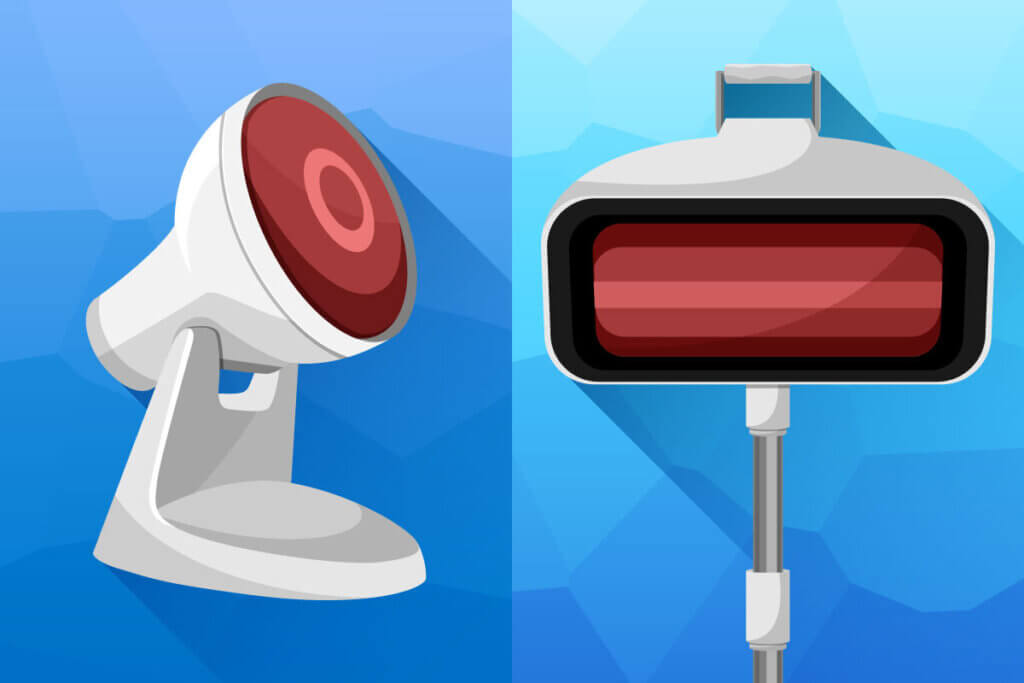
Omnidirectional floodlight
Omnidirectional floodlights are compact lightweights that can easily be used as tabletop units and are easy to stow away or transport – for example, on holiday. Thanks to the easily adjustable angle of inclination, they can be used in many different ways. Such lamps are suitable for selective application because the heat rays are concentrated on a small area. A large-area treatment is therefore not possible. For hard-to-reach areas of the body, users also need the help of a second person.
Pro points
- Targeted application
- Flexible use
- Low weight
- Mobility
Drawbacks
- Small radiant surface
- Cannot always be used alone
Panel radiators
Panel radiators are the heavier and usually larger models. This makes transport and handling more difficult and requires more space or storage. The floor-standing units are sometimes placed on the table with the help of a stand. As a rule, their range of applications is limited. On the other hand, such lamps offer a particularly large, powerful and thus very deep-acting blasting surface. Due to the higher wattage, higher electricity costs are incurred depending on the frequency of use.
Pro points
- Large radiant surface
- Deep-acting
- Powerful
Drawbacks
- Higher energy consumption
- High weight
- Requires a lot of space
- Difficult to transport
What should I look for when buying an infrared lamp?
Before buying a red light lamp, both general and specific criteria should be considered. The first category includes size, weight and price. In the special section, aspects of performance and features are highlighted. Specifically, the general power and area output, the tilt angle and elements such as a timer, an operating switch and the cable length are meant. The criteria of overheating protection and ventilation also play an important role.
Output in watts
The power of infrared lamps is given in watts and is between 100 and 300 watts for most devices for domestic use. In addition, there are more powerful area lamps with an output of up to 600 watts. The decision as to which wattage is suitable depends on the depth effect: the higher the wattage, the more deeply effective the radiation. However, not all body zones require a pronounced infrared effect; after all, the skin is sensitive in different ways.
Low wattage for cosmetic applications
If you are primarily aiming for cosmetic benefits, you can opt for a lower wattage because such treatments take place on the surface. In addition, it is usually a targeted application on the face. There, the skin is much thinner and more sensitive compared to the thighs or the back.
Area power
The area power refers to the irradiation field. It is usually lower with omnidirectional lamps because such models work more precisely than area lamps. On average, the area output of circular radiators is 15 x 20 centimetres. In the case of floodlights, it is about twice as large: 30 x 40 centimetres.
Angle of inclination
The more angles of inclination that can be set, the more flexible are the possibilities for using the infrared lamp. Ideally, the adjustment should be stepless or have at least five steps. This usually applies to small, compact and lightweight models. Such devices stand on a table. There, the angle of inclination can be adjusted easily and quickly by hand to irradiate different parts of the body. If you are looking for a powerful device that can be used as flexibly as possible, you should dig a little deeper when researching products, because there are also floor lamps with an adjustable lamp.
Timer
Timers in infrared lamps can be set either variably in intervals of up to 15 minutes or in predefined periods of 5, 10 and 15 minutes. This is particularly practical because an infrared lamp should not be used for too long at a time for two reasons:
- Increased risk of skin burns
- Overheating of the unit
With a built-in timer, not only the application time remains in view. Another advantage is that the unit switches off automatically. This is especially important if you tend to fall asleep during treatment or deliberately use the infrared lamp while falling asleep.
Tick-tock tip
If your infrared lamp does not have a timer or the integrated clock is defective, you should set another alarm clock – for example on your smartphone. It is not advisable to measure the duration of an application by feel.
Overheating protection and ventilation
If the infrared lamp is equipped with overheating protection, the lamp will automatically stop operating if it gets too hot. This function is practical because it protects the lamp even more effectively from damage and the user from injury, but it is not essential. An integrated cooling function is much more useful because it directly contributes to the durability of the infrared lamp. Ventilation cools the lamp during operation.
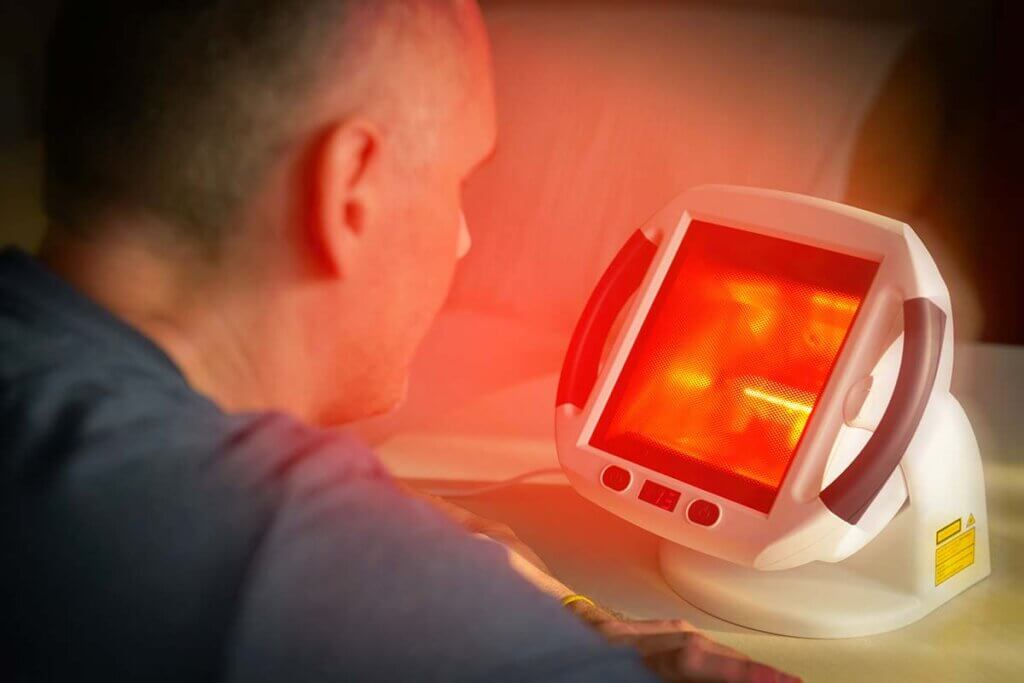
Cable length and switch
The longer the cable, the better you can position devices without using an extension cable – for example, on the bedside table. The best infrared lamps also have an operating switch to turn them on and off. What sounds logical is actually not always present, because some models start as soon as they are connected to a power source. To switch off the red light, the plug has to be pulled out again. Since many people use an infrared lamp for pain relief, any additional movement can be counterproductive. For example, someone who is treating back pain may not want to bend down to the power socket each time to switch the device on and off.
Height and weight
Two clear relationships apply: Larger units are heavier and area lamps are usually larger than circular lamps. The weight of small, compact infrared lamps varies between about 0.5 and 2.0 kilograms. Particularly powerful lamps with a stand weigh up to 10 kilograms. It makes sense to keep an eye on the size and weight, but in most cases the values are automatically determined by the decision for a type of application: area or spot.
Price
The prices of infrared lamps vary depending on the design and features. Often, circular lamps are cheaper than area lamps. The handy models designed for pinpoint application are available for as little as 15 euros and cost up to 60 euros. The price of the larger, more powerful floodlights is between 50 and 200 euros.
Well-known brands
Sanitas | Philips | Beurer | Medisana | Efbe-Schott
Tips on use, risks and care
To clarify the last unanswered questions, we focus on application details, possible risks and the necessary care of infrared lamps.
Regularity and spacing
As a rule of thumb, one application with an infrared lamp lasts between 10 and 20 minutes. Thus, the average treatment time is 15 minutes – this corresponds to the maximum time setting of most heat lamp timers. Two to three sessions per day are fine. In addition, a distance of 30 to 50 centimetres between the body region and the device is recommended.
Although sunburn is not possible from exposure to an infrared lamp, skin redness and burns can occur if used incorrectly – for example, if the body is too close to the lamp, the treatment time exceeds the recommended period or the skin comes into direct contact with the heated lamp.
Pay attention to the body
Anyone who feels discomfort or even an increase in pain during red light treatment should discontinue use and seek medical advice if problems recur.
Risks
Under what circumstances should you refrain from using a red light lamp and what risks lurk when using it outside of product-specific guidelines?
Pregnancy
Since many pregnant women suffer from back pain, the use of an infrared lamp is obvious for them as well. However, caution is advised here. Pregnancy is not a criterion for exclusion, but to be on the safe side you should talk to your doctor before using red light.
Taboos
In some cases, the use of infrared rays is not advisable because certain complaints can worsen – for example:
- Acute inflammation
- Chronic bronchitis
- Tension headaches
- Blood clots
- Fever
People who are not very sensitive to heat should pay more attention to redness, as they can easily burn themselves.
If in doubt, interrupt treatment or consult a doctor
The purchase and use of an infrared lamp can be very beneficial, as heat can have a pain-relieving effect. Nevertheless, the application options and risks are recommendations. In case of doubt, specific complaints or persistent treatment problems, it is advisable to consult a doctor in order to discuss specific application options and conditions in a professional manner.
Care
Cleaning an infrared lamp is not complicated and should be done regularly. House dust in particular can damage your respiratory tract – especially if you suffer from allergies – and the device if the dust burns into the lamp element. Remove dust from the lamp each time before using it and store it as protected as possible, for example in the original packaging. Do not clean the lamp with water while the bulb is hot: it could crack due to the temperature difference.
Basically, it is sufficient to clean the lamp with a soft cloth. Now and then, you can also use a gentle cleaning agent, but under no circumstances should moisture penetrate the lamp.
Replaceability of bulbs
Replacement bulbs for radiant heaters are available online and in some drugstores and electronics stores. However, the bulbs are not always interchangeable. A thorough comparison of infrared lamps is important here. As soon as the radiator fails, you must dispose of the product or, if necessary, send it to the manufacturer.
Alternatives
Although products with a large radiation field cover more of the body, infrared cabins or infrared saunas are more suitable for a whole-body treatment with red light. The question of whether pregnant women are allowed to be in an infrared cabin has not been conclusively clarified. In case of doubt, pregnant women should either refrain from using an infrared sauna or discuss the visit with a doctor. So-called infrared heaters that work at a lower intensity are recommended for small children and babies – for example, to prevent colds.

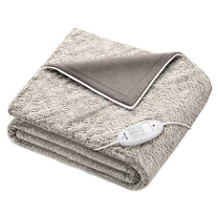

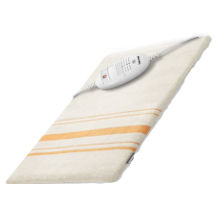
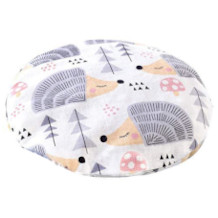
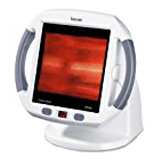

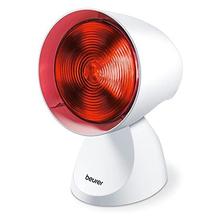
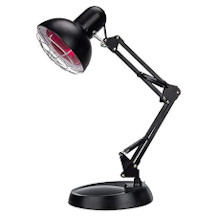
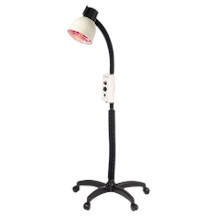
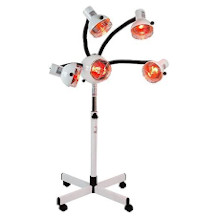

 799 reviews
799 reviews
